Langham/St Neot
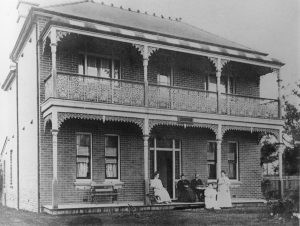
St Neot, Liverpool Road Strathfield South, 1908. Courtesy Jan Jenkins
August is National Family History Month!
Are you interested in your family history? Strathfield Council Library & Innovation Hub now has a subscription to Ancestry Library Edition which can be searched in the library only. Providing access to almost 11,000 databases and millions of international records, it can be a useful resource for genealogists. Access to Ancestry Library Edition can be found at: https://strathfield.spydus.com/cgi-bin/spydus.exe/MSGTRNGEN/WPAC/ANCESTRY using the library’s public computers, or your own device within the library, and the library’s Wi-Fi connection.
Using the photo above as a start, research can provide surprising details about a house and/or family. Information from Ancestry Library Edition can be supplemented with other useful free resources such as the wonderful Trove https://trove.nla.gov.au/ as well as the collections of libraries and archives.
This lovely photo shows the large house, St Neot, in 1908. The home was located on Liverpool Road (Hume Highway) at what would be number 427-429 (formerly 81), near Cross Street, Strathfield South. An apartment block now stands on this triangular site. Using Ancestry Library Edition (Ancestry.com) it is possible to discover more about the family residing there at that time. Sands’ Directories confirm that in 1908 the residents (and owners) were John and Millicent Harding who were the parents of three daughters and one son. So, we can probably presume that the photo shows John and Millicent relaxing on the verandah with daughters, Emily, Millicent and Beatrix.
The house, first known as Langham, was built during the early 1880s and was owned by wealthy widow, Mrs Anthonina Pechey. The choice of house name reflected the family’s ancestral home in Langham, Essex, England. Mrs Pechey was the daughter of politician, Henry Rotton and the half-sister of Caroline Keightley who, in October 1863, rode 25 miles to Bathurst in the middle of the night to secure a 500 pound ransom from her father. Her husband, Gold Commissioner Henry Keightley, was being held by bushranger, Ben Hall and his gang.[1][2] Caroline was accompanied by Dr Pechey (the brother of Anthonina’s future husband), her four-year-old sister and her own small baby. Anthonina was probably in her parents’ house that night when her sister arrived. Henry Rotton dragged the bank manager from his bed in the early hours of a Sunday morning to open the bank and provide marked bank notes for the ransom. Caroline was lauded for her bravery and the story was later used by Rolf Boldrewood in his novel Robbery Under Arms. It was also thought to have been the colony’s first case of ransom.
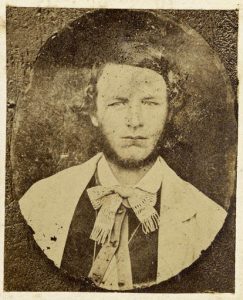
Bushranger, Ben Hall c.1863. Courtesy State Library of NSW
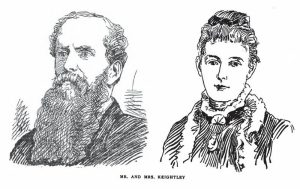
Mrs Pechey was in residence at Langham by January 1884 when she advertised for pupils/boarders to educate with her own five daughters.[4] The following year she again advertised ‘the advantages of a high class education, combined with the requisites of a refined home.’[5] She had been widowed in 1882, when her surveyor husband, Alfred was killed after a dog spooked the horse pulling his carriage near their home, Gestingthorpe, in the Bathurst district. The horse bolted and he was thrown out.[6] He had recently been elected to the NSW Legislative Assembly, but did not live long enough to take up his seat.
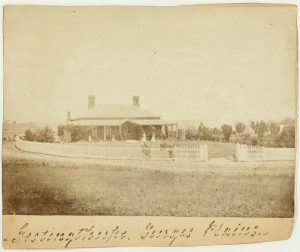
Gestingthorpe, Georges Plains (near Bathurst) – home to the Pechey family, c1870s. Courtesy State Library of NSW
Mrs Pechey stayed at Langham for several years. In 1885, as a property-owner, she signed the counter-petition for the incorporation of Strathfield Council.[7] The petitioners were unsuccessful as Strathfield Council was established later that year.
But by the end of 1886, Mrs Pechey had moved on, leasing the house to Alfred Mitchell. Mrs Mitchell advertised for a ‘general servant’ several times from February 1887. On that occasion she advised prospective applicants that it was the house ‘next to Mr Fells, Walthamstow. Waggonettes from Burwood Station pass every hour.’ [8] Walthamstow still stands at number 425 Liverpool Road.
The Mitchell family had left Langham by 1895 when Sands’ Street Index listed the occupant as Mr Guiseppi Andini, who didn’t stay very long. Mrs Pechey returned to Langham. In October 1897, on the occasion of the opening of the first Strathfield Golf Club, she hosted attendees at Langham. ‘Here, in the grounds there was a large and fashionable gathering of ladies and gentlemen, and afternoon tea was indulged in.’[9]
In February 1900 Mrs Pechey welcomed wedding guests to Langham on the occasion of her daughter Ethel’s marriage to Mr Ernest Quodling. After the ceremony at St Thomas’ Church, Enfield, guests were entertained in a marquee on the lawn at Langham.[10] ‘The Enfield Band was in attendance and played appropriate selections during the afternoon.'[11] Anthonina Pechey moved again soon after this as the Blenkin family was in residence by 1902 when Mr G.H. Blenkin invited friends to the funeral of his wife.[12] In 1913 she was residing in Parramatta. She died in Stanmore in 1922.
By 1905 Langham was briefly renamed Laurensic during the occupancy of Mr Robert Howarth. However the Harding family soon purchased the house, naming it St Neot, possibly after the village in Cornwall. The Hardings remained some years at St Neot, where John’s mother, Elizabeth died in November 1921. His wife, Millicent Harding died the following month and her funeral cortege departed from St Neot for Rookwood Cemetery.[13] Eldest daughter, Emily had married the previous year. Neither Millicent nor Beatrix married but their widowed father, John did remarry in 1930 to Helena Ladner, a neighbour at Belwood, number 35 (now 381) Liverpool Road. The Harding family appears to have moved to Belwood, with St Neot offered for sale at auction in November 1934.[14] However it was Depression-era and it appears the house did not sell.
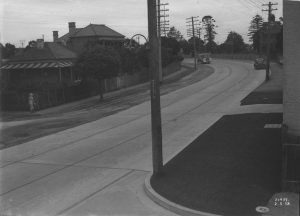
Liverpool Rd from Edward St Strathfield South, 1938. Courtesy NSW State Archives & Records
This 1938 photo, taken from the corner of Edward Street alongside the old fire station, shows St Neot still standing across the road with the house, once known as Exeter, alongside it at number 431. This house still stands, although its verandah has disappeared. Today, a newer house also stands on the corner of Cross Street.
John Harding died in December 1941[15] and the house was sold after this time. St Neot was briefly owned by Brian Francis Gallagher, a veterinary surgeon from North Strathfield, before being purchased by Able Seaman Frederick Haskell in about 1950. Haskell and his family were the last and longest residents of St Neot as it appears that they leased the house from about 1935. Mrs Haskell’s family, the Brays, were also in residence. Elizabeth Clifton Bray died there in November 1946.[16] Frederick Haskell was still living there in 1968 but the house was demolished soon after that and the current block of 12 flats was built.
Every house has a story to tell. Langham/St Neot stood for almost 90 years, entertaining wedding guests, educating pupils and farewelling family members. So many people were able to call it home.
By J.J. MacRitchie
Local Studies Advisor
References
[1] Sydney Mail 31 October 1863 p.4 https://trove.nla.gov.au/newspaper/article/166657611[2] Truth 15 April 1951 p.28 https://trove.nla.gov.au/newspaper/article/168039806
[3] Robbery Under Arms – Wikipedia https://en.wikipedia.org/wiki/Robbery_Under_Arms
[4] Sydney Morning Herald 2 January 1884 p.2 https://trove.nla.gov.au/newspaper/article/28372879
[5] Sydney Morning Herald 28 March 1885 p.3 https://trove.nla.gov.au/newspaper/article/13577021
[6] Wagga Wagga Advertiser 8 June 1882 p.3 https://trove.nla.gov.au/newspaper/article/101817557
[7] New South Wales, Australia, Government Gazette 11 February 1885
[8] Sydney Morning Herald 18 February 1887 p.12 https://trove.nla.gov.au/newspaper/article/13627192
[9] The Sydney Mail and New South Wales Advertiser 23 October 1897 p.886 https://trove.nla.gov.au/newspaper/article/163799389
[10] The Manaro Mercury and Cooma and Bombala Advertiser 2 March 1900 p.3 https://trove.nla.gov.au/newspaper/article/119040150
[11] Daily Telegraph 3 March 1900 p.7 https://trove.nla.gov.au/newspaper/article/237154785
[12] Sydney Morning Herald 10 March 1902 p.10 https://trove.nla.gov.au/newspaper/article/14435629
[13] Sydney Morning Herald 29 December 1921 p.5 https://trove.nla.gov.au/newspaper/article/15977170
[14] Sydney Morning Herald 27 October 1934 p.12 https://trove.nla.gov.au/newspaper/article/17125099
[15] Sydney Morning Herald 6 December 1941 p.25 https://trove.nla.gov.au/newspaper/article/17777398
[16] Sydney Morning Herald 25 November 1946 p.16 https://trove.nla.gov.au/newspaper/article/18003577
